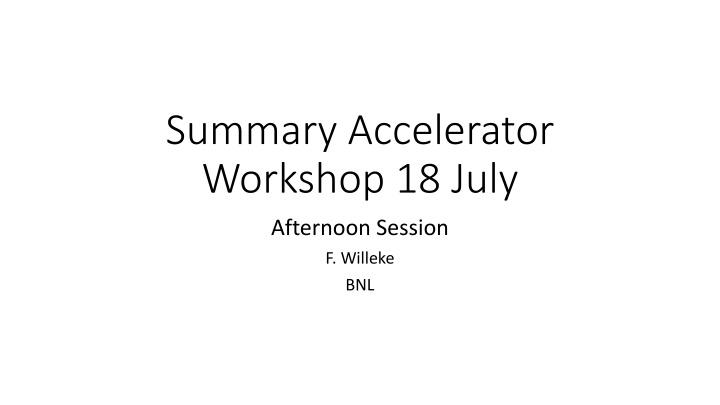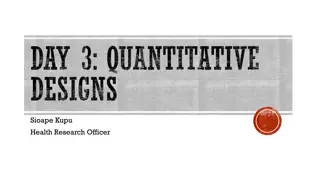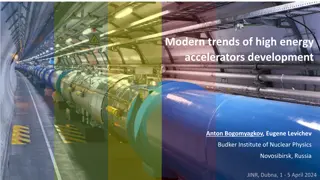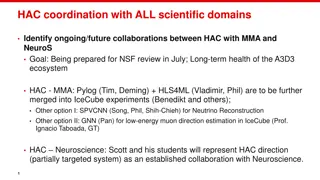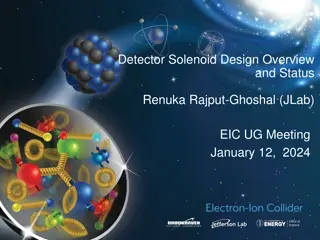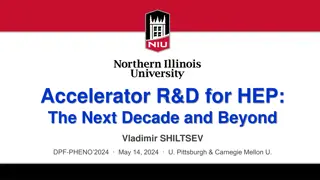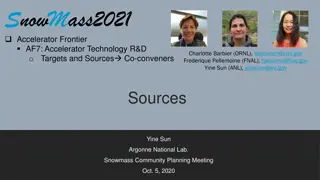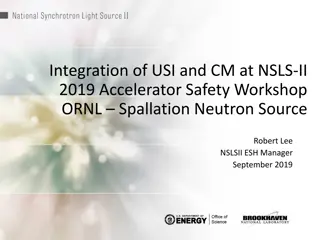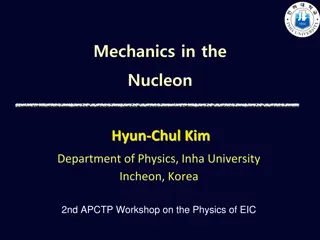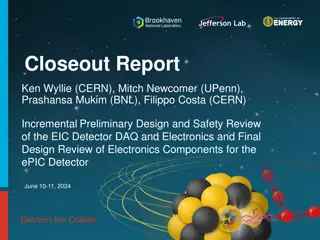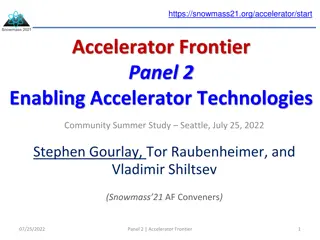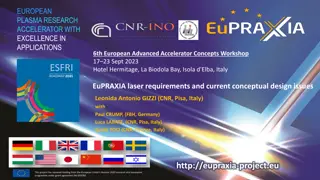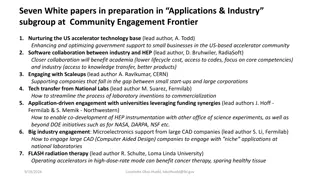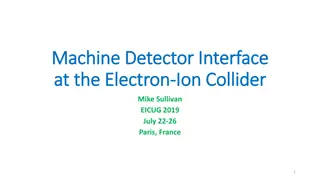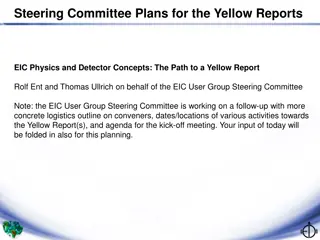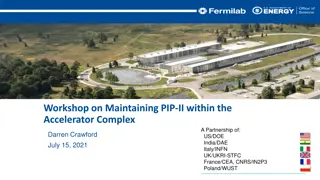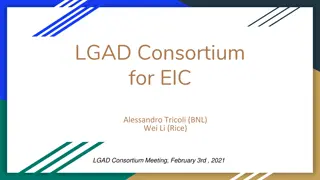Accelerator Workshop Summary on EIC Designs and Collaborations
This summary of the Accelerator Workshop held on 18th July delves into the comparison of EIC designs, common elements, and expertise collaborations between BNL and JLAB. The workshop highlighted key aspects such as beam dynamics, superconducting technology, and ongoing collaborations for developing the EIC project.
Download Presentation

Please find below an Image/Link to download the presentation.
The content on the website is provided AS IS for your information and personal use only. It may not be sold, licensed, or shared on other websites without obtaining consent from the author.If you encounter any issues during the download, it is possible that the publisher has removed the file from their server.
You are allowed to download the files provided on this website for personal or commercial use, subject to the condition that they are used lawfully. All files are the property of their respective owners.
The content on the website is provided AS IS for your information and personal use only. It may not be sold, licensed, or shared on other websites without obtaining consent from the author.
E N D
Presentation Transcript
Summary Accelerator Workshop 18 July Afternoon Session F. Willeke BNL
Agenda Overview of the JLEIC Design, Overview of the eRHIC Design EIC Beam Dynamics, Advanced Hadron Cooling Concepts Bunched Beam Electron Cooling Vasiliy Morozov Christoph Montag F. Willeke (for Michael Blaskiewicz) Vadim Ptitsyn Yuhong Zhang Superconducting Magnet Technology, Gianluca Sabbi Superconductng RF for EIC, Jiquan Guo
EIC Design Comparison EIC Design Comparison eRHIC JLEIC 8-100(400) GeV 3-12 GeV 8 GeV 3
Different Designs Many Common Elements Despite the fact that the two designs are based on different boundary conditions and that they differ in shape and size There are many common challenges and R&D items Layout of the interaction region and machine-detector integration Large aperture superconducting IR septum quadrupoles and dipoles Superconducting RF cavities Similar beam dynamic challenges: beam-beam effects, high beam current, many bunches Crossing angle geometry and crab cavities Need for strong hadron cooling using electron beams Spin Polarized electron- and ion-sources There is plenty og opportunity for collaboration between BNL and JLAB on EIC R&D
Complementary Expertise Complementary Expertise BNL Expertise: Ion/proton beam sources Ion acceleration Ion Spin preservation Hadron beam dynamics RF for hadron beams Hadron beam instrumentation Superconducting Magnets Storage Ring Beam Physics Electron Cooling JLAB Expertise: Polarized Electron Sources Superconducting RF development Superconducting RF production and industrialization Superconducting LINAC technology Superconducting LINAC beam physics Acceleration and transport of polarized Electron beams Strong BNL-JLAB collaboration will help to make EIC designs more compelling and thus will make an EIC project more likely, But will have little impact on the site decision
Ongoing Collaboration JLAB/BNL Superconducting IR magnets using Nb3Sn technology (starting up, dedicated DOE funding) Polarized electron guns Beam-Dynamics Simulations (in particular beam-beam interaction) Crab Cavity development Ist planned common collaboration meeting (at BNL October 9-12, 2017) Includes collaboration with FNAL, ANL, LBL, SLAC, TAMU Welcome potential collaborators from Europe,
EIC Beam Dynamics Combines the challenges of high performance e+e- colliders and hadron colliders Adds EIC specific beam dynamic aspects JLEIC and eRHIC have common beam dynamic challenges Topics Discussed Electron cloud effect (eRHIC) (also important for SuperKEK-B, LHC HL, .) Coherent single bunch instabilities (eRHIC, JLEIC) mostly for eRHIC Electron beam heating (eRHIC, JLEIC) mostly for eRHIC Coupled bunch instabilities (eRHIC, JLEIC) Electron-Ion Beam-beam effects (eRHIC, JLEIC), EIC specific aspect Beam dynamics with Crab Cavities (eRHIC, JLEIC), also relevant for LHC Dynamic aperture (eRHIC, JLEIC) relevant for all high performance colliders and light sources Polarized beam storage (eRHIC, JLEIC) Acceleration of polarized beams (eRHIC, JLEIC) Intrabeam Scattering and electron cooling (JLEIC, eRHIC) This suggests strong collaboration between the accelerator labs on beam dynamcs, in particular, but not limited to BNL-JLAB collaborations, collaborations with other labs including European labs expted to be mutually beneficial Planned Meetings ICFA Miniworkshop on dynamic aperture, Beijing, September 2017 Beam-Beam Workshop LBL, Spring 2018
Electron Cooling of HADRON Beams Two presentations: Overview of Hadron Cooling techniques by Vadim Ptitsyn Specific presentation on Bunched Electron Cooling (Choice for JEIC design) by Yuhong Zhang Need for Cooling EIC hadron beam are subject to Intrabeam-scattering (Lorentz boosted bunch internal Coulomb scattering) This does not allow to reduce the beam size (beam emittance) to the extend required for high luminosity There is consensus that high luminosity in an EIC collider depends on the feasibility of strong hadron cooling Strong means: Cooling times < 1h Classical methods such as microwave stochastic cooling are insufficient (cooling times ~5- 10 hours)
Cooling Overview Standard methods: Classical electron cooling with DC electron beam from an electro-static accelerato is useful only at low energy of a few GeV (gamma<10), may be used for precooling of EIC beam Cooling rates greatly improved by solenoidal fields in cooling channel Microwave stochastic cooling, works at all energies, but cooling rated limited by bandwidth of pickups, amplifiers and kickers of <30 GHz Bunched Beam Electron Cooling Electrons accelerated in RF structures, reach larger energies (multi MeVs electron multi GeV hadron beam) Is implemented and will be used in RHIC FY18/19 low energy run Solenoidal fields make cooling more powerful, but need to produce fields in solenoidal fields, but accelerations is without solenoid complicated beam transport, extreme alignment requirement on solenoid Cooling rate still scales with 5/2 need very large electron (amps) currents to cool EIC hadron beam requires multi-turn cooler rings and ERL for energy recovery to make it affortable (JLEIC Cooling Scheme) Novel techniques: Coherent Electron cooling, Like stochastic cooling, but use electron beam as pick-up and amplifier, FEL based amplifier, so far exists only on paper and in simulation, demonstration experiment underway Microbunching cooling, same principle, but use space charge and wakefields and amplifying mechanism (eRHIC Cooling Scheme) Optical stochastic cooling (use photons as pick-ups and kickers) Lively discussions on Hadron Cooling feasibility R&D Efforts for EIC
Technology Part Superconducting Magnets Superconducting RF
Superconducting Magnet Technology Superconducting magnet technology is vital for feasibility of EIC designs: Superconducting long dipoles for JLEIC (energy range) Superconducting large aperture, high gradient quadrupoles for IR design
Superconducting Magnet Technology State of the Art Nb Ti Alloy require temperatures below 10 K (usually 4.5 K) Is very mature technology (large magnet systems like Tevatron, HERA, RHIC, LHC ..) Current density limiting Jc <4000Amm-2 @ 4.2 K , B <~5T Strong Dependence of Jc on external magnetic Field Field strength for accelerator magnets practically limited at around 7 T (LHC) New techniques such as direct winding (developed for HERA, used at BEPC-II, SuperKEKB..) allows for large aperture, very high field quality but moderately high fields
Nb3Sn similar maximum current density but shifted to higher values of magnetic field B<15 T Allows in principle magnets up to 15 T (FCC magnet concept) Technology very cumbersome (accelerator community spent 4 decades in developing the techniques) Material is pulverized or in thin wire form, needs to be cured at high temperature after which is become brittle and extremely hard to handle Jc depends on pressure: sophistocated mechanical design to manage pre-pressure and operating pressure, quench propagation critical Technology is well developed now, should be well suited for EIC IR magnet (prototype in Collaboration JLAB/BNL, dedicated DOE funding underway)
HTS HTS Available since end of the 80-ties, Bi and Yttrium compounds are best suited Jc very insensible to external magnetic fields: allows in principle magnets with B>20T Even more difficult to wind coils (Bi in thin layers on tape YBCO in power form) needs decades of development to go
HTS Technology Challenges Bi2Ca2CuSr2O8+x (Bi-2212) YBa2Cu3O7- (YBCO) Process W&R (900C, pure Oxygen) Sensitive temperature variations; high pressure requires for high Jc Can use Rutherford cables (routinely fabricated since ~2000) W (pre-reacted tape) Scalability (current) Difficult; Roebel cable under investigation Winding Can use existing processes Challenge: minimum bend radius, no hard-way bends Dep. on field orientation Isotropic Highly anisotropic; being addressed Strain dependence Degradation starts at 60 Mpa in present wires; little reversible regime expected Reversibility improving; transverse pressure limitations
Superconducting RF A large number of different superconducting RF is required for each of the EIC solutions Systems being developed are benefitting from the SRF development of the linear collider development (TESLA, ILC) Both eRHIC (ring-ring design) and JLab EIC (JLEIC) are electron-ion colliders designed to deliver high luminosities up to above 1034/cm2/s for meeting the requirements of the EIC science program To achieve this luminosity goal, both designs chose ampere level high beam current electron/ion collider rings, with short bunch length, high bunch reprate, and low emittance (hadron cooling needed). The beam current in the electron ring of both designs is mainly set by the 10MW administrative limit in synchrotron radiation power. The parameters will be similar to the B-factory storage rings (PEP-II and super KEKB), with more challenges from wide electron energy range. Short bunch length (cm level) is unprecedented in the ion ring and will be a challenge for the RF system. Strong hadron cooling requires high current (Ampere level) low energy (20-140MeV) electron beam. Crabbing in hadron collider requires a strong crabbing RF voltage and is unproven. Both EIC teams collaborate closely with HiLumi LHC crab cavity development. Both designs need to inherit some real estates from existing accelerators. Both designs are still evolving and becoming more self-consistent
Introduction: RF Cavities for JLEIC 952.6 MHz i-ring (SCRF) JLEIC Collider Rings i-SRF + NCRF 952.6 MHz cooler ERL (SCRF) BB cooler e-RF IP Crab 476.3 MHz e-ring (NCRF PEP-II) e-RF Crab Future IP Booster 952.6 MHz cooler booster (SCRF) SRF Linac ODU Ion Source 952.6 MHz crab (SCRF) Hall D Electron Injector 12 GeV 1497MHz CEBAF Harmonic Fast kicker for cooling ring Halls A, B, C Not including ion acceleration and bunch formation 19
Introduction: eRHIC RF Cavities 5-cell injector linac cavity with ridged waveguide HOM damper Two-cell 563MHz SRF cavity for e-ring, under development DQW SRF crab cavity, 337.8MHz, under development 28MHz accelerating cavities 56MHz QWR SRF storage cavity, newly developed
Conclusion Results presented and discussed at Accelerator workshop demonstrate considerable maturing of EIC designs There are many communalities in design feature and in required accelerator technology JLAB and BNL are agreeing that it will be mutually beneficial to collaborate on common aspects of both designs There are many synergies with accelerator projects elsewhere Collaboration with other US and non-US institutions are highly encouraged and will be very welcome
